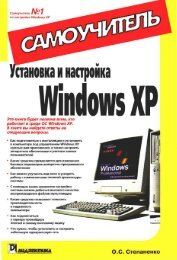You also want an ePaper? Increase the reach of your titles
YUMPU automatically turns print PDFs into web optimized ePapers that Google loves.
FEATURE AOE3<br />
THE HOME CITYEnsemble adds some RPG to AOE3<br />
BY FAR, AOE3’S BIGGEST INNOVATION IS THE<br />
home city, which brings an element of persistence to<br />
both your single- and multiplayer games and adds a<br />
ton of new strategy to the mix.<br />
It works like this: When you first start the game in<br />
skirmish or multiplayer mode, you choose to play as<br />
one of eight civilizations, each of which has a home<br />
city. (See page 50 for details on skirmish mode and<br />
the eight civilizations.) The home city represents<br />
your HQ back in Europe—for example, if you’re<br />
playing as Spain, your home city is Seville. While<br />
your conquistadors are off in the New World, Seville<br />
is supporting their endeavors with shipments of<br />
resources, civilians, technology, and military units<br />
that you specify and send so that they show up on<br />
the New World map while you’re playing. In return,<br />
your exploits in the New World—everything from<br />
shooting bears to building structures—gain you XP<br />
that allow you to level up your home city…which in<br />
turn opens up opportunities for new, better shipments<br />
to your New World minions, and more opportunities<br />
to make those shipments.<br />
AGE OF EMPIREQUEST<br />
Think of the home city as an RPG character. In an<br />
RPG, the first thing you do is create a character;<br />
here, you name your town. In an RPG, the more you<br />
play, the more your character levels up; here, the<br />
more you play, the more your city levels up. As it<br />
does, you get access to upgrades and customization<br />
options (tweaks to architecture, different units,<br />
texture tweaks), but more important, leveling up<br />
affects the type and number of shipments you can<br />
send. Just like in an RPG, there are more powerful<br />
things deeper in the tech tree—you can send some<br />
shipments at level 20 that weren’t available to you in<br />
level 10. You can send shipments every few minutes<br />
(the better you play, the less waiting time between<br />
sending opportunities), and the number of ship-<br />
46 > COMPUTER GAMING WORLD<br />
> More<br />
than anything, the home city<br />
affects players’ strategies—how they’re<br />
used can turn the tide of a game.<br />
ments you can make increases as you level up.<br />
You begin with 12 possible shipments. You may<br />
use one on something you send once, such as a<br />
technology, while you use a bunch of them on<br />
something you send repeatedly, like villagers. At<br />
the end of the game, if you have sufficient XP, you<br />
level up and can choose an additional shipment to<br />
add to your arsenal. In the next game, you’ll have<br />
13 shipment options instead of 12. Developer<br />
Ensemble is guessing that a grand total of 100<br />
potential shipments will become available to players<br />
who have established a fully developed home<br />
city, but the limit for use in any given game is 20.<br />
That’s the point at which you’ll have to start making<br />
choices before each game: Which 20 shipments do<br />
you want to bring in? Says Shelley, “It’s kind of like<br />
building different Magic: The Gathering decks. If<br />
I’m playing this guy and he favors one strategy, I’ll<br />
play a particular city with a particular set of shipments<br />
because they’re particularly good against<br />
what I think he’s going to do.”<br />
In practice, you can play and level up as many<br />
home cities as you choose, though Ensemble<br />
believes the typical player will probably have one<br />
city per civilization. A particularly hardcore player,<br />
though, might have 20 home cities with different<br />
build-outs—three for each civilization. Home cities<br />
are also separate for single- and multiplayer games,<br />
with level disparities handled by restrictions aimed<br />
at keeping things fair and focused on strategy.<br />
Decks will be “tiered” by level, so that, for example,<br />
any cards you receive from levels 0 through 9 will<br />
make a tier 1 deck. Levels 10-25 will be tier 2, and<br />
so on. If you have a deck with even a single tier 3<br />
card, then you have a tier 3 deck. And you can only<br />
play a tier 3 deck against other tier 3 players. So a<br />
guy with a level 50 home city can play a level 1 newbie—but<br />
he can only use cards available at the lowest<br />
levels. “It’s not like World of WarCraft,” says<br />
Street, “where if I’m level 30 and you’re level 35 I<br />
have no chance against you.”<br />
CHOICE STRATEGIES<br />
More than anything, the home city affects players’<br />
strategies—what shipments are sent and when<br />
they’re sent can turn the tide of a game. Looking to<br />
win with a booming economy? Focus your shipment<br />
choices on villagers, food, and technologies that will<br />
help to improve your colony. Seeking a military rush<br />
victory? Be sure you’ve got shipments that let you<br />
send in the cavalry and be ready to send in army<br />
units when your opponents don’t expect it.<br />
Defending against a military rush? Consider “saving<br />
up” shipments so you have emergency supplies in<br />
case of attack.<br />
Despite the RPG analogy, Street is quick to point<br />
out that Age of Empires III “is still an RTS, and skill<br />
really matters. If you squander your shipments or<br />
get attacked really early or something, it’s still possible<br />
for someone who’s much more skilled than you<br />
to win, even at a lower level. An RTS is about highlevel<br />
choice. It’s about reacting to what another<br />
player does, not having a system where 14 games<br />
ago you got this technology that I didn’t get and<br />
now, because of the map we picked, I’m probably<br />
going to lose as soon as the game starts.”






